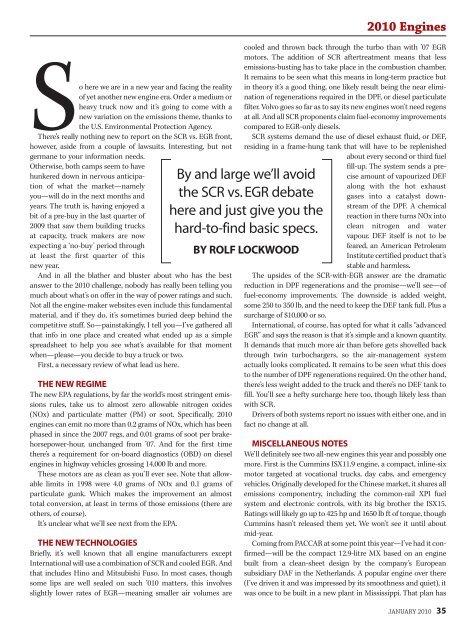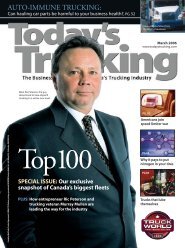Create successful ePaper yourself
Turn your PDF publications into a flip-book with our unique Google optimized e-Paper software.
So here we are in a new year and facing the reality<br />
of yet another new engine era. Order a medium or<br />
heavy truck now and it’s going to come with a<br />
new variation on the emissions theme, thanks to<br />
the U.S. Environmental Protection Agency.<br />
There’s really nothing new to report on the SCR vs. EGR front,<br />
however, aside from a couple of lawsuits. <strong>In</strong>teresting, but not<br />
germane to your information needs.<br />
Otherwise, both camps seem to have<br />
hunkered down in nervous anticipation<br />
of what the market—namely<br />
you—will do in the next months and<br />
years. The truth is, having enjoyed a<br />
bit of a pre-buy in the last quarter of<br />
2009 that saw them building trucks<br />
at capacity, truck makers are now<br />
expecting a ‘no-buy’ period through<br />
at least the first quarter of this<br />
new year.<br />
And in all the blather and bluster about who has the best<br />
answer to the 2010 challenge, nobody has really been telling you<br />
much about what’s on offer in the way of power ratings and such.<br />
Not all the engine-maker websites even include this fundamental<br />
material, and if they do, it’s sometimes buried deep behind the<br />
competitive stuff. So—painstakingly, I tell you—I’ve gathered all<br />
that info in one place and created what ended up as a simple<br />
spreadsheet to help you see what’s available for that moment<br />
when—please—you decide to buy a truck or two.<br />
First, a necessary review of what lead us here.<br />
THE NEW REGIME<br />
The new EPA regulations, by far the world’s most stringent emissions<br />
rules, take us to almost zero allowable nitrogen oxides<br />
(NOx) and particulate matter (PM) or soot. Specifically, 2010<br />
engines can emit no more than 0.2 grams of NOx, which has been<br />
phased in since the 2007 regs, and 0.01 grams of soot per brakehorsepower-hour,<br />
unchanged from ’07. And for the first time<br />
there’s a requirement for on-board diagnostics (OBD) on diesel<br />
engines in highway vehicles grossing 14,000 lb and more.<br />
These motors are as clean as you’ll ever see. Note that allowable<br />
limits in 1998 were 4.0 grams of NOx and 0.1 grams of<br />
particulate gunk. Which makes the improvement an almost<br />
total conversion, at least in terms of those emissions (there are<br />
others, of course).<br />
It’s unclear what we’ll see next from the EPA.<br />
THE NEW TECHNOLOGIES<br />
Briefly, it’s well known that all engine manufacturers except<br />
<strong>In</strong>ternational will use a combination of SCR and cooled EGR. And<br />
that includes Hino and Mitsubishi Fuso. <strong>In</strong> most cases, though<br />
some lips are well sealed on such ’010 matters, this involves<br />
slightly lower rates of EGR—meaning smaller air volumes are<br />
2010 Engines<br />
cooled and thrown back through the turbo than with ’07 EGR<br />
motors. The addition of SCR aftertreatment means that less<br />
emissions-busting has to take place in the combustion chamber.<br />
It remains to be seen what this means in long-term practice but<br />
in theory it’s a good thing, one likely result being the near elimination<br />
of regenerations required in the DPF, or diesel particulate<br />
filter. Volvo goes so far as to say its new engines won’t need regens<br />
at all. And all SCR proponents claim fuel-economy improvements<br />
compared to EGR-only diesels.<br />
SCR systems demand the use of diesel exhaust fluid, or DEF,<br />
residing in a frame-hung tank that will have to be replenished<br />
about every second or third fuel<br />
fill-up. The system sends a pre-<br />
By and large we’ll avoid<br />
the SCR vs. EGR debate<br />
here and just give you the<br />
hard-to-find basic specs.<br />
cise amount of vapourized DEF<br />
along with the hot exhaust<br />
gases into a catalyst downstream<br />
of the DPF. A chemical<br />
reaction in there turns NOx into<br />
clean nitrogen and water<br />
vapour. DEF itself is not to be<br />
feared, an American Petroleum<br />
<strong>In</strong>stitute certified product that’s<br />
stable and harmless.<br />
The upsides of the SCR-with-EGR answer are the dramatic<br />
reduction in DPF regenerations and the promise—we’ll see—of<br />
fuel-economy improvements. The downside is added weight,<br />
some 250 to 350 lb, and the need to keep the DEF tank full. Plus a<br />
surcharge of $10,000 or so.<br />
<strong>In</strong>ternational, of course, has opted for what it calls “advanced<br />
EGR” and says the reason is that it’s simple and a known quantity.<br />
It demands that much more air than before gets shovelled back<br />
through twin turbochargers, so the air-management system<br />
actually looks complicated. It remains to be seen what this does<br />
to the number of DPF regenerations required. On the other hand,<br />
there’s less weight added to the truck and there’s no DEF tank to<br />
fill. You’ll see a hefty surcharge here too, though likely less than<br />
with SCR.<br />
Drivers of both systems report no issues with either one, and in<br />
fact no change at all.<br />
BY ROLF LOCKWOOD<br />
MISCELLANEOUS NOTES<br />
We’ll definitely see two all-new engines this year and possibly one<br />
more. First is the Cummins ISX11.9 engine, a compact, inline-six<br />
motor targeted at vocational trucks, day cabs, and emergency<br />
vehicles. Originally developed for the Chinese market, it shares all<br />
emissions componentry, including the common-rail XPI fuel<br />
system and electronic controls, with its big brother the ISX15.<br />
Ratings will likely go up to 425 hp and 1650 lb ft of torque, though<br />
Cummins hasn’t released them yet. We won’t see it until about<br />
mid-year.<br />
Coming from PACCAR at some point this year—I’ve had it confirmed—will<br />
be the compact 12.9-litre MX based on an engine<br />
built from a clean-sheet design by the company’s European<br />
subsidiary DAF in the Netherlands. A popular engine over there<br />
(I’ve driven it and was impressed by its smoothness and quiet), it<br />
was once to be built in a new plant in Mississippi. That plan has<br />
JANUARY 2010 35



